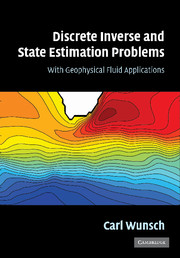1 - Introduction
Published online by Cambridge University Press: 28 October 2009
Summary
The most powerful insights into the behavior of the physical world are obtained when observations are well described by a theoretical framework that is then available for predicting new phenomena or new observations. An example is the observed behavior of radio signals and their extremely accurate description by the Maxwell equations of electromagnetic radiation. Other such examples include planetary motions through Newtonian mechanics, or the movement of the atmosphere and ocean as described by the equations of fluid mechanics, or the propagation of seismic waves as described by the elastic wave equations. To the degree that the theoretical framework supports, and is supported by, the observations one develops sufficient confidence to calculate similar phenomena in previously unexplored domains or to make predictions of future behavior (e.g., the position of the moon in 1000 years, or the climate state of the earth in 100 years).
Developing a coherent view of the physical world requires some mastery, therefore, of both a framework, and of the meaning and interpretation of real data. Conventional scientific education, at least in the physical sciences, puts a heavy emphasis on learning how to solve appropriate differential and partial differential equations (Maxwell, Schrödinger, Navier—Stokes, etc.). One learns which problems are “well-posed,” how to construct solutions either exactly or approximately, and how to interpret the results.
- Type
- Chapter
- Information
- Discrete Inverse and State Estimation ProblemsWith Geophysical Fluid Applications, pp. 3 - 18Publisher: Cambridge University PressPrint publication year: 2006

